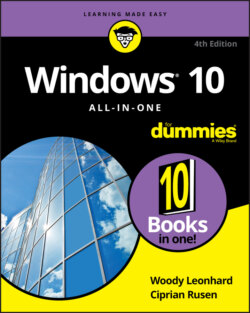Читать книгу Windows 10 All-in-One For Dummies - Ciprian Adrian Rusen, Woody Leonhard - Страница 19
WINDOWS RT, RIP
ОглавлениеBack in the early days of Windows 8, Microsoft developed a different branch of Windows that was christened Windows RT. New Windows RT computers at the time were generally small, light, and inexpensive. They had a long battery life and touch-sensitive displays.
Several manufacturers made Windows RT machines, but the only company that sold more than a dumpster full of them was Microsoft. Microsoft’s original Surface (later renamed Surface RT) and Surface 2 ran Windows RT — and even they didn’t sell worth beans.
The fundamental flaw with Windows RT? It wasn’t Windows. You couldn’t (and can’t) run classic Windows programs on it. You can’t upgrade the machine to real Windows. But try explaining that to a garden-variety customer. Microsoft blew it when they gave the new, odd operating system the name Windows RT.
The company has essentially orphaned Windows RT. If you own a Windows RT device (most likely a Microsoft Surface or Surface 2), the folks in Redmond provided one last update, called Windows RT 8.1 update 3, which plugs what little they could muster. See www.microsoft.com/surface/en-us/support/install-update-activate/windows-8-1-rt-update-3.
In the tablet sphere, iOS and Android rule, with iOS for iPhones and iPads — all from Apple — and Android for smartphones and tablets from a bewildering number of manufacturers. Windows 10 doesn’t exactly compete with any of them. However, Microsoft tried to take on iPad with the now-defunct Windows RT (see the sidebar “Windows RT, RIP”) and is trying to dip its billion-dollar toe back in the bare-bones water with Windows 10 S mode and the upcoming Windows 10X.
Yet another branch of Windows is geared toward phones and tablets, especially 8-inch and smaller tablets. Windows 10 Mobile (see the sidebar) owes its pedigree to Windows Phone 8 and Windows RT. At least conceptually (and, in fact, under the hood in no small part), Microsoft has grown Windows Phone up and Windows RT down to meet somewhere in the middle. As we went to press, Windows 10 Mobile was dead. Today, no one creates smartphones with Windows 10 Mobile.
Windows 10 in S mode is a relatively confusing development with an unclear future. Designed to compete with ChromeOS and iPads, S mode refers to a set of restrictions on “real” Windows 10. Supposedly in an attempt to improve battery life, reduce the chance of getting infected, and simplify your life, the S mode versions of Windows 10 won’t run most regular Windows programs. S mode limits users only to apps found in the Microsoft Store. You get Spotify, iTunes, but not Google Chrome or Firefox.
Fortunately, Windows 10 S mode systems can be upgraded so that they’re no longer in S mode. For most people who want more than the basics, that’s a smart move. If you find that you can’t run real Windows programs on your Windows 10 in S mode machine, look into dropping S mode.
What do other people choose? It’s hard to measure the percentage of PCs running Windows versus Mac versus Linux. One company, StatCounter (www.statcounter.com), specializes in analyzing the traffic of 3 million sites globally and provides lots of useful statistics based on the data they collect. One stat is tallying how many Windows computers hit those sites, compared to macOS and Linux. Although their data may not be 100 percent representative of real-world market share, it does an excellent job of giving us an idea of operating system penetration. If you look at only desktop operating systems — Windows (on desktops, laptops, 2-in-1s) and macOS X — the numbers in April 2020 (according to StatCounter) break as shown in Figure 1-3. (Linux and ChromeOS, the two bottom lines, have barely more than 1 percent market share, each).
In April 2020, Windows (the top line) had a market share of 76.52 percent of all desktop operating systems, and macOS (the second line from the top) had 18.99 percent. In Microsoft’s world, Windows 10 is king with a 73.14 percent market share. Windows 7 is a distant second, with 19.44 percent, and constantly declining, as Microsoft has declared its end of life on January 14, 2020. As of this date, users are no longer receiving support and updates for Windows 7 and are highly encouraged to upgrade to Windows 10.
